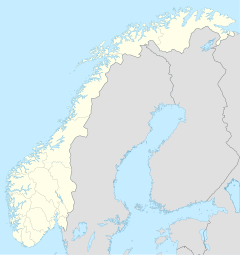Lindesnes fyrstasjon

View of the lighthouse
|
|
| Location | Vest-Agder, Norway |
|---|---|
| Coordinates | 57°58′56″N 07°02′47″E / 57.98222°N 7.04639°ECoordinates: 57°58′56″N 07°02′47″E / 57.98222°N 7.04639°E |
| Year first constructed | 1656 (original) 1915 (current) |
| Automated | 2003 |
| Foundation | Granite |
| Construction | Cast iron |
| Tower shape | Cylindrical |
| Markings / pattern | White with red top |
| Height | 16.1 metres (53 ft) |
| Focal height | 50.1 metres (164 ft) |
| Original lens | 1st order Fresnel lens |
| Range | 17.7 nmi (32.8 km; 20.4 mi) |
| Characteristic | FFl W 20s |
| Admiralty number | B3058.1 |
| NGA number | 1676 |
| ARLHS number | NOR-028 |
| Norway number | 082200 |
Lindesnes Lighthouse (Norwegian: Lindesnes fyr) is a coastal lighthouse at the southernmost tip of Norway, about 10 kilometres (6.2 mi) southwest of the village of Høllen in Lindesnes municipality in Vest-Agder county. The present lighthouse was built in 1915, although the station was first built in 1656 to mark the entrance to the Skaggerak and the Baltic Sea from the North Sea. The current 16.1-metre (53 ft) tall lighthouse is cast iron with a granite foundation. The lighthouse is painted white, with a red top. The light sits at an elevation of 50.1 metres (164 ft) and it emits a fixed and flashing white light that is always on and it rotates between a low intensity and high intensity light every 20 seconds. The light comes from a first order Fresnel lens that can be seen for up to 17.7 nautical miles (32.8 km; 20.4 mi).
The lighthouse was first built in 1656 and over the centuries several more were built to replace the older ones. In 1822, the lighthouse was refitted with a coal lamp, and in 1854 a new lamp was installed with the current lens. The current cast iron tower was set up in 1915 and fitted with the old Fresnel lens. In 1920, the lighthouse station got its first fog signal, a siren. The fog signal and its machinery is placed in a building beside the tower.
During World War II the lighthouse was taken over by the Germans. Being an important watchpoint, the Germans built a small fortress with four guns and, after a while, a radar antenna. The traces from World War II are still visible as trenches, tunnels, and other fortifications.
In the 1950s, the lighthouse station was electrified and the fog signal was replaced with a powerful Diaphone. The fog signal was closed as a navigational aid in 1988, but it is still operational and is used on special occasions.
...
Wikipedia


